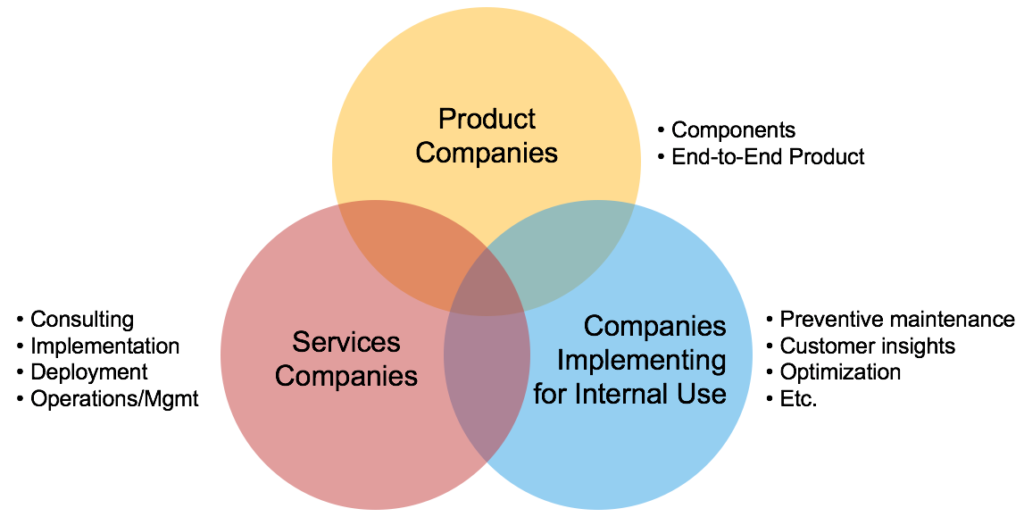
These days, more and more companies are kickstarting IoT (Internet of Things) product initiatives, and these companies have a strong need for skilled professionals that can handle the complexity of IoT. These professionals include engineers, data scientists, designers, and of course, IoT Product Managers.
But the IoT industry is very young, and both companies and Product Managers are still trying to understand what skill sets are needed in this new era of technology.
So it’s no surprise that the number one question I get from fellow PMs is, “How can I transition into IoT Product Management?”
In this post, I’ll outline what it means to be an IoT PM and how you can get started on your journey.
1. Make Sure Your Basic Product Management Skills Are Solid
At the end of the day, Product Management for IoT is still Product Management.
It is true that some key differences make managing IoT products very complicated. But before we get into those, I’d like to take a step back and emphasize that regardless of the product, technology, or industry you are in, the role of the Product Manager is always the same: to build products that add value to your customers and your company.
If you already have experience managing a tech product, then you are already ahead of the curve. All that experience is directly applicable to IoT. Experience understanding and validating users’ needs, creating the business case, defining and prioritizing requirements, building roadmaps, working with engineering, managing up, and more, are all skills that you can put to work in IoT right away.
If you don’t have experience in Product Management today, I recommend starting your PM career path working on a non-IoT product to get your feet wet before jumping into the more complex world of IoT. Having a few releases under your belt on either hardware or software products will make it a lot easier to get the attention of IoT companies.
2. Understand the Full IoT Technology Stack, and Be an Expert in at Least One Layer
Although we call them IoT “products,” in reality as an IoT PM, you are building a system. That’s because an IoT product has five layers of technology, which is what we call the IoT Technology Stack. These layers are:
- Device hardware
- Device software
- Communications
- Cloud platform
- Cloud applications
If this concept is new to you, I recommend reading my IoT Primer for Product Managers.
As you can see, IoT products are a lot more complicated than, say, a Cloud product, which only has the two Cloud layers listed above. And each of these five layers could be considered a product in its own right. So managing an IoT product is like managing a portfolio of five products.
The challenge of switching to IoT Product Management is that you now have to understand the relationship and interdependencies of all five layers.
The good news is that most hiring managers understand that it’s improbable to have a single person manage an end-to-end IoT solution. So unless you are in a tiny startup, chances are you’ll be working with other Product Managers that specialize in the different layers of the IoT stack.
This is where the concept of a “T-shaped” Product Manager comes into play. An IoT Product Manager needs to have a solid horizontal understanding of all five layers of the IoT Technology Stack and how the end-to-end system works. And then you should complement that with in-depth vertical knowledge in one of the layers of the IoT Technology Stack.
For example, if you have experience managing a mobile app, then you are already familiar with Cloud platforms and Cloud applications. To get into IoT, you should focus on learning (at a higher level) how the other three layers of the IoT Technology Stack work (device hardware, device software, and communications) and how all layers relate to each other. That way, you’ll be an expert in two layers and be skilled enough to have intelligent conversations with other teams about the complete system.
Now, if you have hardware experience, then you are already familiar with the device hardware layer. But to get into IoT, you need to understand how the other four layers work, at least well enough to participate in strategic discussions about the end-to-end product and to coordinate with the Product Managers for the other layers.
Related post: A Product Management Framework for the Internet of Things
3. Understand What Types of Companies You Could Work for
If you are new to IoT, it can be very daunting to understand which companies are doing what. A good first step is to understand the types of companies working in IoT so you can get an idea of the potential opportunities they might have and a better picture of how your skill set could be a match.
This diagram shows the three types of companies I’ve identified:

Let’s take a look at each company type.
Product Companies:
As the name implies, product companies are building IoT products to sell to other companies or consumers. Companies that make end-to-end products are the ones that get the most press and buzz. These companies provide a finished product that includes the five layers of the IoT Technology Stack.
But building an end-to-end product is not the only way to work in IoT. Since IoT systems are very complex, many companies focus on developing specific components of the IoT Technology Stack.
For example, some companies focus only on the Cloud Platform, others only on the analytics, others only on hardware components, etc. So if you are already an expert in one or two layers of the IoT Technology Stack, it might be easier to find opportunities if you go after companies that also specialize in that layer. Say you already have Cloud experience; then, you’ll have an edge when applying to a company providing IoT Cloud platforms.
Services Companies:
By services, I don’t mean the “as-a-service” business model (which is important in IoT by the way). Instead, I’m referring to companies that provide professional services to take customers through the last mile of their implementation. You can see that some of the biggest consulting companies like Accenture, Bain, Tata, and others have (or are building) IoT practices to meet the growing demand they see from their customers worldwide.
Services companies have a wide range of services that span the whole lifecycle of IoT products, including strategy consulting, development outsourcing, deployment, field services, and asset management, to name a few.
Many of professional services companies often build internal tools or products to accelerate the timeline of the services they provide. These internal tools need Product Managers, so don’t think there’s no room for us in services companies.
Companies Implementing for Internal Use:
The third group is companies that are looking at IoT as a new way to solve existing problems. Their goal is not to release an IoT product out to the market, but to connect existing equipment to the Internet so they can optimize their processes and get better visibility into their performance.
Think of an industrial company looking for new ways to optimize their manufacturing plant to improve their yields. By connecting their manufacturing equipment to the Internet (which turns them into smart devices), they’ll be able to act on new data that can lead to process and automation optimization.
The takeaway here is that these companies are building products. They are internal products, but products nonetheless. Despite all the hype around smart homes or wearables, industrial applications for process optimization is the most significant area where IoT is making a difference today, and it can be an excellent opportunity for you to get started in the IoT world.
Notice the three types of companies I include in the Venn diagram above. The reason is that there’s a lot of overlap between the three types. In the IoT world, many product companies offer services. Many professional services companies build internal products. And some industrial companies develop products for internal use and to sell to others.
These blurry boundaries add complexity, but also provide an excellent opportunity for Product Managers to expand our horizons and learn the big picture of how complex product ecosystems work.
4. Focus on a Specific Industry
“IoT” is an umbrella term that encompasses everything from smart toasters to self-driving cars to smartwatches and everything in between. Given this lack of clarity, it’s easy to see why people are so confused about how to get started pursuing an IoT PM role.
My recommendation is to focus on an industry in which you’ll be able to leverage your existing domain knowledge. This will make you more attractive to companies and will make it easier for you to start conversations with them. For reference, some of the industries in which IoT is having the most significant impact include (in no particular order):
- Smart homes
- Smart cities
- Smart buildings
- Healthcare
- Wearables
- Transportation
- Energy
- Manufacturing
- Retail
- Drones
- Agriculture
5. Learn from People Already Working in IoT
The best way to learn, especially about a new topic or industry, is to learn from people already doing that work. Identify companies you are interested in and reach out to the IoT Product Managers there via LinkedIn. Attend meetups and trade shows. Find publications (blogs, magazines, podcasts, etc.) that you like and read everything they produce. In short, find a way to educate yourself by learning from others.
If you’d like to listen to how other IoT PMs approach their products, I highly recommend subscribing to my Enterprise Product Leadership.
And you can always stay up to date with the latest trends in IoT Product Management by subscribing to my newsletter.
The Bottom Line
IoT will continue to have tremendous growth in the coming years. And working as an IoT PM is a great opportunity to grow your skills and be a part of one of the most innovative areas of technology today.
By focusing on the recommendations above, you’ll have a much better understanding of what skills are needed and a better chance of breaking into IoT Product Management. Good luck!
PS – this post was originally published as a guest article for Mind the Product.
4 Comments
-
Its a very clear guidance for IOT product managers. Really thankful to you for this article.
I can find lots of material for IOT developers hardly for managers, so happy to read it….on the way to implement…will be requiring more guidance.-
Thank you for your comment Shilpi. I’m working on new content for the implementation stages, so that material is coming! In the meantime, have you listened to my podcast? iotproductleadership.com In every episode I interview executives from IoT companies who talk about their strategy and implementation approach. I think you’d find it very valuable.
-Daniel
-
-
Daniel,
Great article. I love the concept of starting with the fundamentals. You’ve also “peeled the layers”
of IoT back in a most helpful manner.I did something similar in an article on the digital leadership mindset vs. old-school leadership behaviors in this article: http://leadership4ir.com/2017/09/27/digital-leadership-mindsets/. Your readers might find it helpful as they’re thinking about advancing their leadership chops for the digital age.
Keep up the good work! The world needs it!
See you in the future,
Chris
Leadership4ir.com-
Thanks Chris!
And thanks for sharing your article. It’s an interesting view. I agree that one of the biggest challenges for companies to overcome in this transformation is having the right mindset and training for their people.-Daniel
-